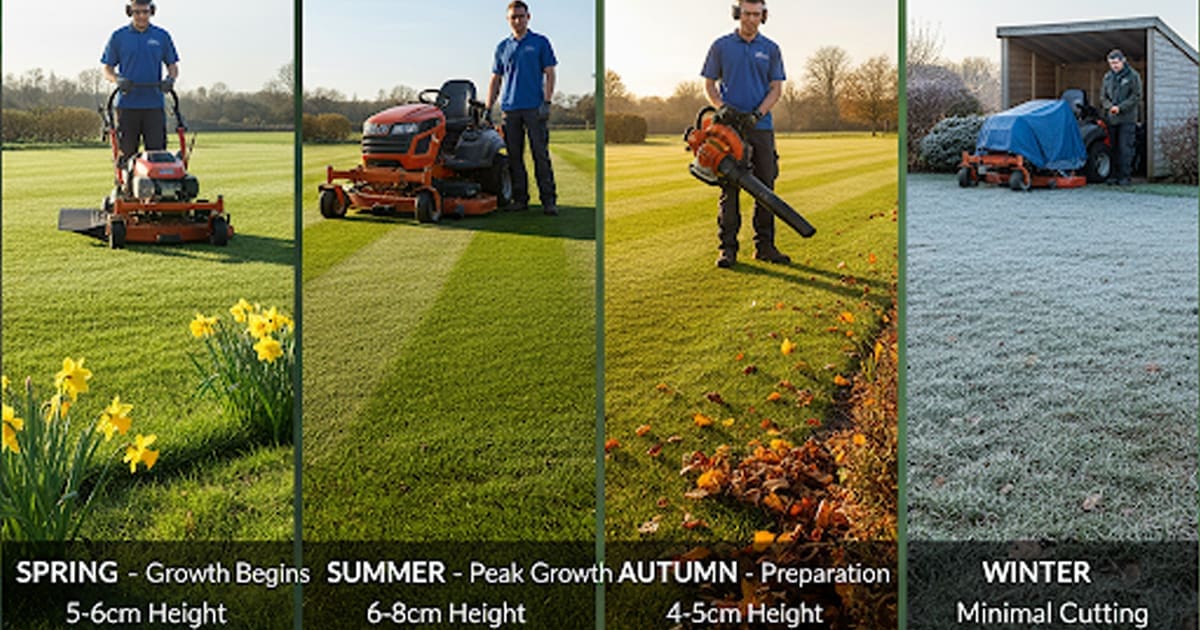Professional insights from 4 Seasons Grounds Maintenance & Landscaping Solutions
After two decades of maintaining grounds across the Midlands, we’ve learned that grass cutting isn’t a one-size-fits-all approach. Each season brings unique challenges and opportunities. Your lawn’s needs shift dramatically from January to December, and understanding these changes makes the difference between average grass and exceptional turf.
Spring: The Growing Season Begins
March to May: Setting the Foundation
Spring grass cutting requires careful timing. We typically begin our first cuts when grass reaches 7-8cm in height. This typically occurs in mid-March, although recent climate patterns have shifted the timing earlier.
The first cut should remove only the top third of the blade. Cutting too short after winter dormancy can shock the grass and weaken root development. We set our mowers to 5-6cm for this initial cut.
Frequency Changes Fast
April brings rapid growth spurts. What starts as monthly cutting quickly becomes weekly maintenance. Soil temperatures above 6°C trigger active growth, and spring rain accelerates this process.
We closely monitor soil moisture levels during the spring. Wet conditions mean waiting for drier periods to avoid soil compaction. Our teams often reschedule cuts based on ground conditions rather than rigid calendar dates.
Spring Equipment Considerations
Sharp blades are critical in spring. Winter storage can dull cutting edges, and sharp blades prevent tearing wet grass. We sharpen all mower blades before the season starts and inspect them weekly during peak growth periods.
Collecting grass clippings becomes important in spring. Heavy growth produces thick clippings that can smother new growth if left on the surface. Our mulching mowers handle light clippings well, but we collect and remove heavier debris if required.
Summer: Peak Performance Period
June to August: Precision Maintenance
Summer grass cutting follows different rules. Heat stress becomes the primary concern, and cutting height increases to protect root systems. We typically raise the cutting height to 6-8cm during hot periods.
Weekly Rhythm
Most properties require weekly cutting during the summer months. However, drought conditions can significantly slow growth. We adjust schedules based on actual growth rather than automatic weekly visits.
Early morning cuts are most effective in summer. Grass recovers quickly from morning cuts, and moisture levels are optimal. We avoid cutting during midday heat or in the evening when the grass stays wet overnight.
Water and Heat Management
Summer cutting requires understanding water stress signals. Grass that springs back slowly after walking indicates drought stress. We raise the cutting height and reduce frequency during these periods.
Shaded areas often need different treatment than sunny spots. Our teams adjust the cutting height based on sun exposure across each property. Shaded grass typically needs higher cutting to capture available light.
Clipping Management
Summer clippings break down quickly in warm weather. Light clippings can remain on the lawn as natural fertiliser. Heavy clippings get collected to prevent thatch buildup and disease problems.
Autumn: Preparation Time
September to November: Getting Ready for Winter
Autumn grass cutting focuses on preparing for winter. Growth slows but continues until soil temperatures drop below 5°C. This usually happens in November across the Midlands.
We gradually reduce the cutting height in autumn. The final cut of the season occurs at a height of 4-5cm. This prevents winter disease and pest problems while avoiding scalping damage.
Frequency Reduction
September often requires weekly cuts as grass makes a final growth push. October cuts become fortnightly, and November may require only one or two cuts, depending on the weather.
Rain patterns significantly affect autumn cutting schedules. Wet autumns extend the growing season and require more frequent cuts. Dry conditions end the season earlier.
Leaf Management
Autumn brings leaf fall challenges. Heavy leaf cover blocks light, creating favorable conditions for disease. We clear leaves before cutting and ensure clippings don’t mix with leaf debris.
Our teams use leaf blowers before cutting to clear surface debris. This prevents clogging mower decks and ensures clean cutting action. Leaves get composted separately from grass clippings.
Winter: Minimal Intervention
December to February: Dormancy Period
Winter grass cutting happens rarely. Most grasses enter dormancy when soil temperatures remain below 5°C. However, mild winters can occasionally trigger growth that requires attention.
When winter cutting becomes necessary, we use the highest mower setting available. Winter cuts remove only diseased or damaged material. Healthy dormant grass stays untouched.
Equipment Storage
Winter provides equipment maintenance time. All mowers receive comprehensive services, including blade sharpening, oil changes, and mechanical inspections. This preparation ensures reliable operation when spring arrives.
Professional Equipment Considerations
Blade Sharpness
Sharp blades matter more than most people realise. Dull blades tear grass instead of cutting cleanly. Torn grass loses moisture quickly and becomes vulnerable to disease.
We sharpen blades every 8-10 hours of cutting time. Commercial properties with tough grass conditions might need more frequent sharpening. Signs of dull blades include brown grass tips and ragged cutting edges.
Mower Height Adjustment
Professional mowers allow precise height control. We calibrate all machines at the start and verify settings on a weekly basis. Uneven cutting height creates a patchy appearance and stressed grass areas.
Different grass types need different heights. Fine fescue lawns are cut shorter than ryegrass areas. Mixed grass areas require compromise heights that suit the dominant species.
Mulching vs Collection
Mulching works well when clippings are short and light. The rule of thumb: if clippings are visible after cutting, they should be collected. Heavy clippings block light and create favorable conditions for disease.
Our teams make collection decisions based on clipping volume rather than automatic rules. Spring growth often produces an excessive amount of material for effective mulching.
Weather Impact Management
Rain Patterns
Heavy rain creates challenging conditions. Wet grass clumps easily and can clog mower decks. We delay cutting until surface moisture drops to manageable levels.
Extended wet periods require schedule flexibility. Our teams monitor weather forecasts and adjust routes accordingly. Customer communication becomes important when the weather disrupts normal schedules.
Drought Conditions
Drought stress changes cutting requirements dramatically. We raise the cutting height and reduce the frequency when the grass shows signs of stress. Drought-stressed grass recovers slowly from the damage caused by cutting.
Irrigation changes cutting schedules. Well-watered grass continues to grow during dry periods and requires regular cutting. Unirrigated areas might need monthly attention instead of weekly cuts.
Temperature Extremes
Hot weather above 30°C creates stress conditions. We avoid cutting during peak heat and focus on early morning schedules. Grass cut in extreme heat often develops brown tips and requires longer recovery time.
Cold snaps can damage grass that’s been cut too short. We monitor weather forecasts and avoid late cuts before predicted freezes.
Commercial vs Residential Considerations
Usage Patterns
Commercial properties often require a consistent appearance, regardless of the growing conditions. Schools require a pristine appearance during term time. Hotels require ideal conditions for their guest areas.
Residential properties allow more flexibility. Homeowners often accept longer intervals during periods of slow growth. However, neighbourhood standards still matter for property values.
Budget Constraints
Commercial clients typically prefer consistent monthly costs. We design service packages that spread seasonal variations across the year. This provides budget predictability while ensuring the provision of appropriate care.
Residential customers often prefer pay-per-visit arrangements. This works well for basic maintenance but can create scheduling challenges during peak periods.
Professional Tips for Property Managers
Communication Matters
Clear communication prevents problems. We explain seasonal variations to new clients and provide advance notice of schedule changes. Weather delays are easier to accept when clients understand the reasons.
Flexibility Requirements
Grass doesn’t follow calendar schedules. Professional service requires flexibility to match natural growth patterns. Rigid schedules often produce poor results and frustrated clients.
Long-term Planning
Seasonal planning improves results and efficiency. We review the previous year’s records and weather patterns to predict upcoming needs. This helps with resource allocation and customer communication.
The Science Behind Seasonal Changes
Growth Patterns
Grass growth follows patterns of temperature and daylight. Cool-season grasses, such as ryegrass, grow fastest in the spring and autumn. Warm-season grasses peak during the summer months.
Understanding these patterns helps predict maintenance needs. Spring preparation and autumn cleanup become more important than summer frequency adjustments.
Photosynthesis Requirements
Grass needs an adequate blade surface for photosynthesis. Cutting too short reduces energy production and weakens plants. Seasonal height adjustments balance appearance needs with plant health requirements.
Root Development
Different seasons affect root growth differently. Spring root development requires careful cutting to avoid shocking new growth. Summer root protection needs longer grass blades for shade and moisture retention.
Professional grass cutting adapts to these natural cycles rather than fighting them. The result is healthier grass, better appearance, and more satisfied clients throughout the year.
Understanding seasonal grass cutting requirements transforms maintenance from routine mowing into precision turf management. Each season presents opportunities to enhance grass health and appearance through targeted cutting practices.

